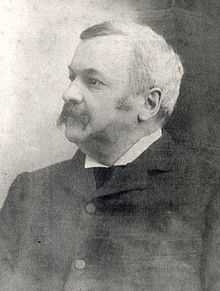Frederick Peters
| Frederick Peters | |
|---|---|
 | |
| 6th Premier of Prince Edward Island | |
| In office April 27, 1891 – October 27, 1897 | |
| Monarch | Victoria |
| Lieutenant Governor | Jedediah Slason Carvell George William Howlan |
| Preceded by | Neil McLeod |
| Succeeded by | Alexander B. Warburton |
| Personal details | |
| Born | April 8, 1851 Charlottetown, Prince Edward Island |
| Died | July 29, 1919 (aged 68) Prince Rupert, British Columbia |
| Nationality | Canadian |
| Political party | Liberal |
| Spouse(s) | Bertha Susan Hamilton Gray (m. 1886) |
| Relations | James Horsfield Peters (father) |
| Children | Frederick, Helen, Noel, Gerald, and Jack |
| Residence | Charlottetown, Prince Edward Island Prince Rupert, British Columbia |
| Alma mater | Prince of Wales College St. Dunstan’s College |
| Occupation | lawyer |
| Profession | Politician |
| Cabinet | Attorney General (1891-1897) |
| Religion | Anglican |
Frederick Peters (April 8, 1851 – July 29, 1919) was a lawyer and Prince Edward Island politician, who served as the sixth Premier of Prince Edward Island.
Early life and career
Peters was born in Charlottetown and educated at King's College in Nova Scotia. Frederick's parents were Judge James Horsfield Peters (whose grandparents James Peters and Margaret Lester were United Empire Loyalists from New York) and Mary Cunard (eldest daughter of Sir Samuel Cunard). He went on to study law in England and was called to bar there in 1876. He was called to the bars of Prince Edward Island and Nova Scotia later that year and set up practice in Charlottetown.
Political career
A Liberal, Peters won election to the House of Assembly in 1890. He was asked to form a government in 1891 after the Conservative government lost a motion of confidence in the house. The Peters government abolished both the Legislative Council and the House of Assembly and brought in a new legislative assembly to create a unicameral form of government. Peters served as Premier until resigning in 1897 to move to British Columbia though he retained his seat in the legislature until 1899 despite no longer residing in the province.
Legal career in British Columbia
Peters was Chief Counsel for the Great Britain in the Behring Sea Claims Commission, 1896-1897. His associate counsel was Sir Charles Hibbert Tupper, who as Minister of Fisheries was involved in the earlier Bering Sea Arbitration between Great Britain and the United States. The commission held hearings in Victoria, British Columbia from November 23, 1896 to February 2, 1897.[1] This close working partnership, as well as the developing economic conditions on the west coast - particularly with the stampede to the Klondike Gold Rush - encouraged both men to resign their political and legal careers in the Maritimes and begin a joint legal practice in Victoria. Peters and Tupper arrived in Victoria on November 11, 1897.[2] By July 1898 they had opened two partnerships, Tupper, Peters and Potts in Victoria and Tupper, Peters and Gilmour in Vancouver.[3]
In 1911 Frederick Peters left his legal practice and moved north to become City Solicitor for the City of Prince Rupert, British Columbia. He arrived in the north coast town on May 17, 1911 [4] when it was barely one year old (having been incorporated in March 1910). Peters' legal and political experience were important as he helped the community make the transition from a frontier company town to port city. He remained as City Solicitor until his death in 1919.
Personal life
Peters married Roberta Hamilton Susan Gray (daughter of P.E.I. Father of Confederation John Hamilton Gray) in Charlottetown in 1886. They had six children: Mary Helen Peters (1887–1976), Frederick Thornton Peters (1889–1942), John Francklyn Peters (1892–1915), Gerald Hamilton Peters (1894–1916), Noel Quintan Peters (1894–1964) and Violet Avis Peters (1899–1905).[5]
Daughter Violet died in "a fireplace accident" at their home in Oak Bay, British Columbia in 1905.[6] She was buried in Ross Bay Cemetery. When Frederick Peters died in 1919, his remains were brought to Victoria and he was buried beside his daughter. Following his death, Roberta Peters lived with her daughter Mary Dewdney in New Denver, British Columbia. She died in nearby Nelson in 1946.
Two sons, John Francklyn Peters and Gerald Hamilton Peters died in action in World War I. Another son, Frederick Thornton Peters, died in November 1942 five days after action in the Allied invasion of Oran for which he received the Victoria Cross and the U.S. Distinguished Service Cross.
Frederick's brother, Arthur Peters was also active in politics, serving as premier of Prince Edward Island from 1901 to 1908. His cousin Lt. Col. James Peters also had a distinguished military career and was District Officer Commanding in BC, based at Esquimalt, British Columbia.[7]
External links
References
- ↑ Record of evidence taken at Victoria, British Columbia by the commissioners: under the convention of February 8, 1896, between Great Britain and the United States http://www.archive.org/details/cihm_14457
- ↑ Victoria Daily Colonist, November 11, 1897 p. 5
- ↑ Victoria Daily Colonist, July 21, 1898
- ↑ Prince Rupert Daily News, May 17, 1911
- ↑ Genealogical information at http://trees.ancestry.ca/tree/7805322/person/257562556
- ↑ http://www.navalandmilitarymuseum.org/resource_pages/heroes/peters.html
- ↑ James Peters http://www.navalandmilitarymuseum.org/resource_pages/coastal_defence/james_peters.html
| Preceded by Neil McLeod 1889-1891 |
Premier of Prince Edward Island 1891-1897 |
Succeeded by Alexander B. Warburton 1897-1898 |
| ||||||||